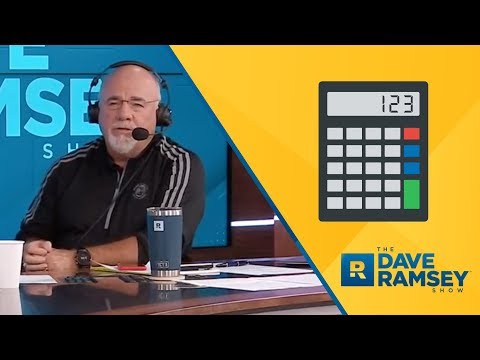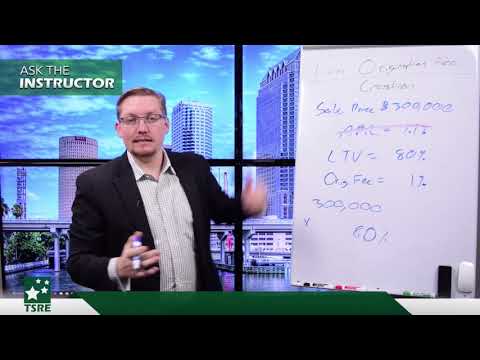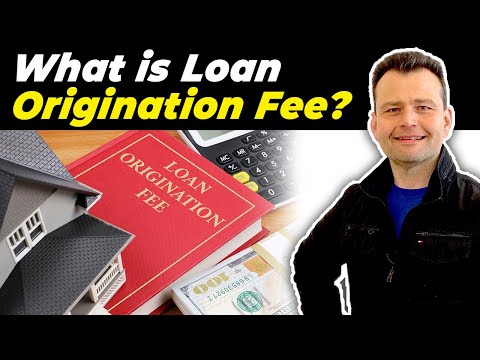Mortgage seekers, strap on your seat belts; we are diving deep into the nitty-gritty of loan origination fees. As you venture into the labyrinth of the mortgage process, knowing the ins and outs of these fees is not just empowering—it’s financially savvy. Think of this article as your trusty map to navigate these waters with the educational tone of Suze Orman and the practical savvy of Robert Kiyosaki.

Understanding the Loan Origination Fee in Today’s Mortgage Landscape
For starters, let’s decipher a loan origination fee: It’s not simply a toll gate on your path to homeownership; it’s a conflation of various costs that lenders incur while processing, underwriting, and funding your loan. Think of it as the cover charge to the exclusive club of homeowners.
Here’s the skinny on what factors into this fee:
– The nitty-gritty of your loan size and terms
– The labor of love from the loan officers and underwriters
– And let’s not forget the administrative ballet that keeps all these moving parts in sync.
Now, what’s the magic number? Generally, you’re looking at about 0.5% to 1% of your princely loan amount. That figure is anything but static; it’s swayed by the ebb and flow of market forces and the lender’s own pricing strategies.

The Evolution of Mortgage Origination Fees in the Past Decade
You might wonder if this fee has waltzed up or down the financial scale over the years. Here’s the tea: Origination fees have seen some roller coaster action over the past decade. At times, they’ve hunkered down below that 0.5% sanctuary, while at others, they’ve inched toward the 1% mark with the cheekiness of a playful squirrel.
Comparing today’s origination fees to those of yesteryears, industry keen beans will point out that advances in technology have lent a hand in stabilizing these costs, preventing them from ballooning uncontrollably.
Now for a quick peek into the crystal ball of origination fees—experts are betting their chips on technology continuing to streamline the loan origination process, ideally keeping these fees from skyrocketing.

| Aspect of Loan Origination Fee | Details |
|---|---|
| Definition | A charge by the lender for processing a loan application. |
| Typical Range | 0.5% to 1% of the loan amount. |
| Cost Example | For a $300,000 loan, fee ranges from $1,500 to $3,000. |
| Negotiability | Fees can sometimes be negotiated, but may result in a higher interest rate or bigger loan amount. |
| Effect on Loan Disbursement | Fee is deducted from the total loan amount (e.g., $10,000 loan with 3% fee gives $9,700 to borrower). |
| Avoidance | Not entirely avoidable; can be paid upfront, by the seller, or through loan terms adjustments. |
| Worth of Paying the Fee | Depends on the loan terms; avoiding it results in a higher accessible loan amount. |
| Impact on Interest Rate | Paying a lower origination fee may lead to a higher interest rate over the loan term. |
| Payment Method | Included in the loan costs and typically not paid as a separate payment. |
| Effectiveness Date | Information accurate as of February 7, 2023, for the avoidance strategies. |
5 Surprising Realities About Loan Origination Fees in 2024
1. Wild Variability: Not All Loan Origination Fees Are Created Equal
If you thought origination fees are a one-size-fits-all affair, think again. You might stumble upon a lender that’s the cat’s pajamas, offering a fee that’s as low as hugging the 0.5% line, while another lender might be lolling about at the 1% ceiling.
Put on your detective hat and let’s explore a real-life scenario: Comparing the likes of Wells Fargo to Quicken Loans, you’ll discover a glaring variability in their origination fees. This just goes to show that a little homework could save you bundles, showing us that when it comes to mortgages, the adage “one man’s meat is another man’s poison” holds true.
2. The Hidden Facets of a Mortgage Origination Fee
You might assume define the origination fee as a straightforward cost, but hold your horses: there’s more than meets the eye. Included in this financial packet might be a gamut of administrative, application, and processing fees—essentially, the whole kitchen sink of mortgage-related costs.
Some lenders will garnish their fees with posh services like expedited processing. That’s akin to getting the VIP treatment at the Met Cloisters—you’ll shell out more dough but relish in the opulence of the service.
3. Negotiability May Be an Option: The Art of The Deal
Haggling over a price may seem as outdated as the cast Of Castle. Yet, there are modern-day homebuyers who’ve chiseled down their origination fees through sharp negotiation. Much like Tricep dumbbell Exercises are vital for arm strength, exercising your negotiation muscles is crucial for financial fitness.
Leverage the competitive lending market to your advantage. Our advice? Approach lenders with the calm confidence of FC Barcelona lining up against Celta Vigo, and you might just score a better deal.
4. The Impact of Origination Fees on Different Loan Types
All loans are not created equal either. The variance in origination fees between FHA, VA, and conventional loans can be as distinctive as the characters in a Mia Farrow film. For example, VA loans often boast a cap on their fees, making the cost as predictable as Thanksgiving dinner at Grandma’s.
When considering refinancing, bear in mind that the origination fee may differ from the purchase of a new home, much as different shoes are designed for running versus a night out on the town.
5. How Cutting-Edge Technology is Reshaping Origination Fees
Staying ahead of the curve, fintech companies like Rocket Mortgage are Exploiting meaning from efficiency to redefine the structure of origination fees. By leveraging automation and artificial intelligence, they’re slicing through the old layers of cost like a hot knife through butter.
The future looks bright for borrowers. As tech keeps evolving, it may chomp down origination fees further, making them as palatable as a Sunday brunch.

When Origination Fees Outweigh the Benefits
We ought to talk turkey about when the origination fee isn’t your cup of tea. Here’s the rub: the balance between short-term gains and long-term costs. A hefty origination fee could be a burden heavier than last year’s fruitcake if it means locking you into a higher interest rate that’ll gnaw at your finances for years to come.
Consider the words of wisdom from those who’ve been down this road; the combined wisdom suggests that sometimes walking away is the smart move, much like turning down a questionable investment opportunity just because it glitters.

How to Spot Reasonable Origination Fees and Avoid Overpaying
Strategy, strategy, strategy. To assure you’re not overpaying, do a swan dive into the details of your loan’s size and type, just as one would deep-dive into meaning Hacking to understand cryptic codes. Seek out expert opinions and chew over what makes for a reasonable fee in the current climate.
In the grand scheme of things, an origination fee aligning with the industry norm and your loan specs (size, type, and creditworthiness) should pass muster.
Conclusion: Navigating the Origination Fee Maze with Confidence
So, there you have it—a robust guide to tying up the loose ends of the loan origination fee enigma. With understanding as your arsenal and negotiation as your sword, you’re well-equipped to embark on this financial odyssey.
No doubt, the landscape will keep morphing, with innovations continually redefining the playbook. Nonetheless, with the insight you’ve gained today, you can waltz into any lender’s office with your head held high, ready to spar for a deal that benefits your pocketbook, now and in the long run.
Remember, the goal isn’t just to land a mortgage; it’s to clinch a mortgage you can live with, as snug as a bug in a rug. Happy house hunting!
Unexpected Twists on the Loan Origination Fee
Alright, folks, gather around! It’s time to dive into the quirky world of the loan origination fee, and boy, do I have some tidbits that’ll make your jaw drop. You might be as shocked as if you suddenly found out your underdog team made an epic comeback during the last minute of a Fc Barcelona Vs Celta vigo matchup.
The Match-Up of the Market
Believe it or not, the loan origination fee can often feel like a nail-biting soccer match. Just when you think you’ve got the rate figured out, it swerves! This fee is like that player you can’t take your eyes off—not because he’s scoring goals, but because he might just pull off an unexpected move that changes the game.
Shake, Rattle, and Roll with the Costs
Speaking of surprises, did you know that getting a loan can be as unpredictable as an earthquake? Sure, there’s insurance For Earthquakes, but for a loan origination fee, the best defense is knowledge. Let’s unpack a few fun facts that’ll keep you on your toes.
The Percentage Puzzle
First off, the loan origination fee usually hovers around 0.5% to 1.5% of the loan amount. But why the range, you might ask? Well, just like football teams switch up their lineups, lenders tweak these fees based on your credit score, the loan’s size, and even which way the economic wind’s blowing. It keeps us on our toes, that’s for sure!
The Negotiation Game
Here’s the kicker—just like haggling at a flea market, lo and behold, you can actually negotiate your loan origination fee. It might feel like a risky play, but with a little charm and a lot of know-how, you could land yourself a sweet deal.
It’s All in the Name
Last but not least, this fee is a bit of a chameleon. With a knack for going incognito, it might show up on your bill under a slew of pseudonyms—processing fees, underwriting fees, you name it. Just like a tricky forward dodging a defender, this fee knows how to blend in.
There you have it—a handful of crazy facts that make the loan origination fee seem a little less snooze and a little more ‘who knew?’ Remember, the goal isn’t just to pay the fees; it’s to understand the playbook so well that when game time comes, you’re the MVP.

What is a typical loan origination fee?
What is a typical loan origination fee?
Hold onto your wallets, because when it comes to typical loan origination fees, you’re looking at about 0.5% to 1% of the loan amount. Think of it as the lender’s way of saying, “Thanks for the paperwork,” as they pocket some cash for processing your application. So, on a $300,000 loan, you might fork over anywhere from $1,500 to $3,000 – ouch!
Can you avoid loan origination fee?
Can you avoid loan origination fee?
Well, aren’t we optimistic! Trying to dodge loan origination fees is like trying to avoid stepping on cracks in the sidewalk — theoretically possible, but you’ll need some fancy footwork. Though it’s tough to completely sidestep them, you could wind up paying through the nose with a higher interest rate or a bigger loan amount instead. Remember, there’s no such thing as a free lunch!
What is the 3% origination fee?
What is the 3% origination fee?
Imagine you’re eyeing a shiny $10,000 from your lender, but there’s a catch – a 3% origination fee. That means before you’ve even started, $300 is going bye-bye to cover processing costs. So, you’re left with $9,700, and the lender is giving you a sly wink. Not the full stack you expected, huh?
Is an origination fee worth it?
Is an origination fee worth it?
Let’s weigh it up – is that origination fee worth its weight in gold? Skipping out on it could mean more moolah in your pocket at first, but don’t get starry-eyed just yet. These fees aren’t necessarily the bad guys; in fact, coughing up an origination fee might make sense if it leads to better loan terms. So, is it worth it? It’s a game of give-and-take – sometimes, yes, sometimes, no.
Can origination fee be waived?
Can origination fee be waived?
Asking if an origination fee can be waived is a bit like asking if you can get a free extra scoop of ice cream – it’s not common, but hey, it can happen on a good day. You can always try your luck negotiating with the lender, but keep it real – they’ve got to make their dime somehow, and your charms might not always work.
Is origination fee upfront?
Is origination fee upfront?
Yup, the origination fee is like the opening act at a concert – it’s upfront. It’s subtracted from the total loan amount before you see a cent, so it’s not an extra bill you’ll have to remember to pay. Instead, it’s more of the “now you see it, now you don’t” kind of thing with your loan money.
Is 2% origination fee high?
Is 2% origination fee high?
If we’re chatting about origination fees, 2% might make you raise an eyebrow – it’s on the steeper side compared to the usual 0.5% to 1%. Let’s just say if a lender hits you with a 2% fee, you might want to put your negotiation hat on or keep shopping around.
Is 1% origination fee high?
Is 1% origination fee high?
One percent origination fee? That’s pretty standard in the loan world. It’s not as sweet as a lower fee, but it’s not sky-high either. Think of it as the industry’s middle-of-the-road – not great, not terrible, just par for the course.
Is a 10% origination fee high?
Is a 10% origination fee high?
Is a 10% origination fee high? You betcha! That’s cruising at stratospheric levels! If a lender’s asking for 10%, it’s a red flag-waving, alarm-bells-ringing kind of high. It’s the “check the contract twice, then run” scenario, unless there’s a very, VERY good reason that fee’s through the roof.
Can you negotiate origination fees?
Can you negotiate origination fees?
Look, rolling up your sleeves and negotiating origination fees might just pay off – quite literally! While it’s not a walk in the park, catching your lender in a good mood or waving a stellar credit score might work to your advantage. You’ve got nothing to lose but a few percentage points if you play your cards right.
Who gets the origination fee?
Who gets the origination fee?
That origination fee? It goes straight into the lender’s piggy bank. They’re the ones doing the heavy lifting with processing the loan, and that fee is their pat on the back, their slice of the pie, their hard-earned reward for dotting the i’s and crossing the t’s.
Who paid the origination fee?
Who paid the origination fee?
Remember playing hot potato as a kid? Well, the origination fee is kind of like that, only with your cash. Typically, it’s you – the borrower – who ends up paying, directly or indirectly. However, sometimes points can change hands in negotiations, and the seller might chip in. But don’t count those chickens before they hatch!
What is the 8% origination fee?
What is the 8% origination fee?
An 8% origination fee sounds like you’re getting smacked with a wet towel – it’s unexpectedly high and definitely stings. On a $10,000 loan, for instance, you’re waving goodbye to $800 right off the bat. This kind of fee should have you questioning the deal or at least sharpening your negotiation skills.
How much does LendingTree charge?
How much does LendingTree charge?
Ah, LendingTree – where they don’t shake you down for an origination fee because they’re not the lender; they’re the matchmaker. They connect you with lenders for free, so they don’t charge you a dime. Instead, they make their money from lenders, who pay to be part of the LendingTree network.
What does 70% LTV mean?
What does 70% LTV mean?
The term “70% LTV” literally means that the loan sharks… er, I mean, lenders… are giving you a mortgage that’s 70% of your home’s value, leaving you to come up with the other 30%. It’s like they’re saying, “We trust you this much, and no further.” Aim for a good LTV ratio, and you might just get friendlier interest rates.
Is an origination fee the same as points?
Is an origination fee the same as points?
Origination fee the same as points? Not quite, even though they both love to crash your wallet’s party. An origination fee compensates for loan processing, while points are a trade-off you pay upfront for a lower interest rate. It’s a bit like choosing between paying more now or paying more later – different flavors of financial fun.
What are banks charging for loans?
What are banks charging for loans?
Banks, the urban money forests, have a little something called interest rates that they charge for loans – it varies like the weather. But there’s also a chance they’ll tack on fees like origination or underwriting fees. It’s kind of like buying a ticket to a show, then realizing there’s a convenience fee on top of it.
How much is the typical loan origination fee quizlet?
How much is the typical loan origination fee quizlet?
So you’re hitting the books, huh? Over at the financial quizlet, they’ll tell you that the usual loan origination fee dances around 0.5% to 1% of the loan amount. Think of it as the cost of doing the loan limbo – how low can those fees go?



